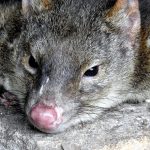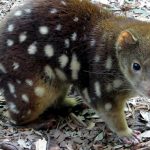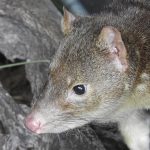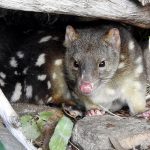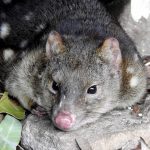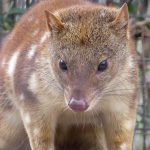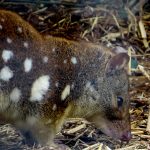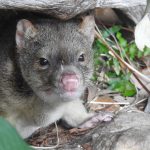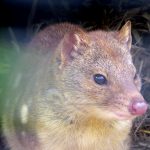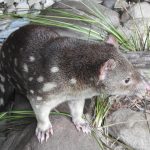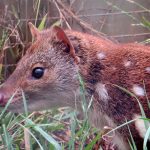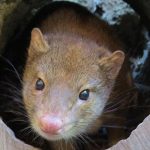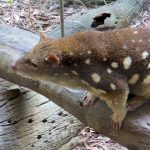QUOLL
Mysterious Carnivorous Marsupials of Australia
Quolls are among Australia’s most captivating marsupials, renowned for their unique characteristics, striking appearance, and crucial role in native ecosystems.
Meet the Family
| Species Name | Common Name | Distribution |
|---|---|---|
| Dasyurus maculatus | Spotted-tailed Quoll | Eastern Australia, Tasmania |
| Dasyurus viverrinus | Eastern Quoll | Tasmania; formerly SE Australia |
| Dasyurus geoffroii | Western Quoll (Chuditch) | South-western Australia |
| Dasyurus hallucatus | Northern Quoll | Northern Australia |
Distinctive Features
- Sharp Teeth & Pointed Snout: Adapted to a carnivorous lifestyle, quolls have razor-sharp teeth and a slender, pointed snout, perfect for catching and consuming prey.
- Prehensile Tail: Their long, flexible tails aid in climbing and balancing, particularly in forested habitats.
- Striking Fur: Visualise rich brown, reddish, or dark fur scattered with white spots. These create a beautiful pattern, providing both camouflage and an air of wild elegance.
Lifestyle & Behaviour
Nocturnal Wonders
Step into the Australian twilight, when the world transforms into a stage for quolls. They become active under the gentle glow of moonlight, using sharp night vision and a highly developed sense of smell to stalk the undergrowth in search of food.
Solitary Adventurers
Quolls are typically solitary. Each animal carves out its own territory, sometimes marked with scent or defended with dramatic vocalisations—growls, barks, screeches, and the distinctive quoll “clucking.”
Daily Life: Diet and Hunting
- Diet: True carnivores at heart, quolls feast on small mammals, birds, reptiles, insects, and occasionally supplement with fruits or other plant matter.
- Hunting Skills: Picture a quoll weaving through tangled forest, silently climbing, pouncing, and pursuing prey both on the ground and up in the trees. Their agility and sharp senses make them formidable hunters and climbers.
Reproduction and Lifespan
- Unique Biology: Female quolls possess a
divided uterus, which enables them to bear multiple litters sired by different fathers—a remarkable adaptation that increases genetic diversity. - Breeding: Mating typically occurs during the cooler months, after which tiny, underdeveloped joeys cling to their mother, seeking the safety of her pouch or belly fur.
- Lifespan: In the wild, quolls live about 3–5 years, while individuals in protected captivity may reach ages of 8–10 years.
Communication
Imagine moving through dense Australian bushland and hearing an orchestra of animal calls. Among them, you might hear a quoll:
- Growl as a warning,
- Cluck or hiss in irritation,
- Screech when threatened.
Each sound serves an important role in territory defence and social interactions.
Conservation: Challenges and Hope
Quolls were once more common across Australia, but face serious threats from:
- Habitat Loss: Urban expansion and agriculture reduce their available land.
- Introduced Predators: Dogs, foxes, and cats pose ongoing dangers.
- Reduced Prey & Competition: Changes to the ecosystem impact food supplies and increase competition.
Conservation Actions
- Securing and restoring native habitats
- Predator control and exclusion zones
- Captive breeding and release programs
Why Quolls Matter
Quolls are not merely survivors but important custodians of their wild realms. They help maintain ecological balance through their role as predators. To encounter a quoll—even just its tracks or distant calls—is to witness a living thread in the fabric of Australia’s natural heritage.
Protecting quolls helps ensure the survival of entire ecosystems, reminding us that each species is a precious part of the story of life.
Imagine Meeting a Quoll
- Visual: Dappled light on fur, quick movement through undergrowth.
- Sound: Quiet rustling, soft clucks, and the occasional sharp screech.
- Smell: The earthy scent of damp leaves—a reminder of their secretive woodland homes.
- Touch: The imagined softness of spotted fur, contrasted by the strength of powerful limbs and claws.
Quolls are extraordinary marsupials—stealthy, striking, and supremely adapted to Australia’s landscapes. Their ongoing survival is a testament to nature’s resilience and a call for us all to protect the precious diversity that makes our world so vibrant.
Let their story inspire us to cherish and defend wild Australia.

